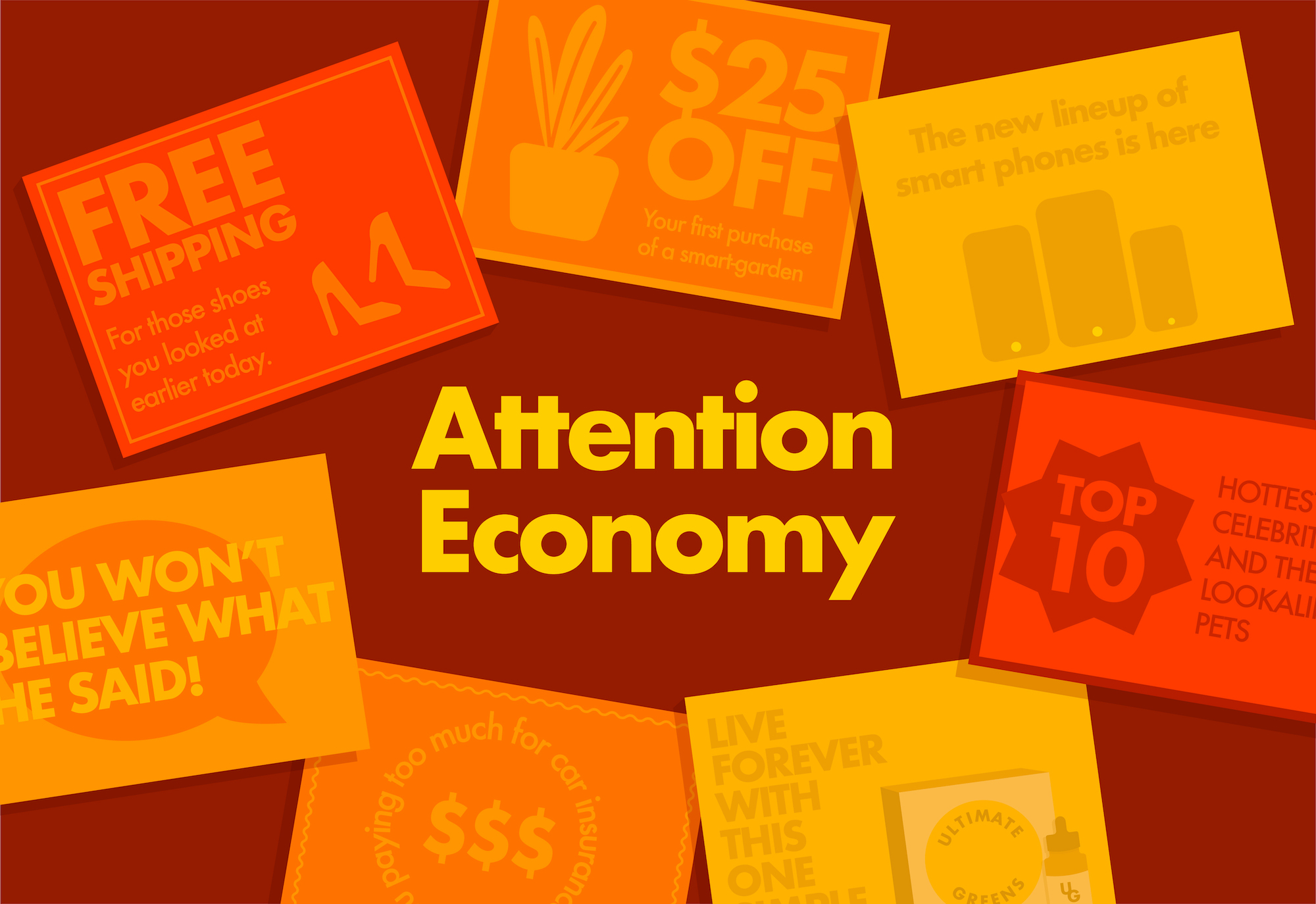

What happens to media as the digital age enhances their ability to engage consumers?
RECOMMENDED READING
Television, not the Internet, first prompted the observation that consumers of free media are the product, not the customer. Television networks were in the business of developing content that would attract “eyeballs,” which they could then sell to advertisers. Scholars warned of the medium’s purported addictiveness and its tendency to devolve into infotainment.
In the Information Era, though, every element of the equation has become amplified. Media platforms know a tremendous amount about each user and can tailor their offerings accordingly. Media themselves have become more immersive and seek to maximize user “engagement.” Users carry devices with them that ensure access to the media—and the media’s access to them—at all times.
These digital media now dominate the landscape, supplanting traditional forms and increasing total consumption. From 2011 to 2020, the average American’s consumption of traditional media (e.g., TV, radio, and print) fell from 450 to about 300 minutes each day, while digital media usage rose from 200 to almost 500 minutes a day. More than a quarter of adults report being online “almost constantly.”
The platforms are designed to retain as well as entertain. With greater data collection, content providers better understand users’ interests and habits and target content accordingly. Most use “A/B testing” to constantly refine their product design and function in search of “stickiness”—keeping users engaged longer and bringing them back sooner. Features such as “infinite scroll” and “autoplay” aim to eliminate breaks in the experience when a user might turn away; YouTube’s personalized recommendations account for more than 70% of the time spent watching.
Platforms also work constantly to reengage users via “push” notifications. People are significantly more likely to engage with an app if they receive regular notifications and are 50% more likely to make an in-app purchase if prompted. Perhaps this explains why the average smartphone user checks his smartphone 96 times and receives 46 mobile notifications each day.
Or he may just be a satisfied consumer. Far from lamenting popular online platforms, most users would pay $25–$50 per year for them, including nearly three-quarters for YouTube and Twitter and two-thirds for Facebook.
This tension is at the heart of competing claims about the nature of modern media: Is there anything wrong with building products that users can’t seem to stop using? Nir Eyal’s Hooked: How to Build Habit-Forming Products provides a Rorschach test. Is a “habit-forming product” a good thing? “Forming habits is imperative for the survival of many products,” writes Eyal. “As infinite distractions compete for [users’] attention, companies are learning to master novel tactics to stay relevant in users’ minds.” That seems sensible enough. But it translates into outcomes such as nearly one-third of Americans aged 18–44 reporting that they feel anxious if they have not checked Facebook in the previous two hours.
Critics argue that companies are hooking users, building products that cause biological changes in the brain and compel continued use. For instance, social media triggers the same regions of the brain as cocaine, and researchers regularly classify frequent social media use as an addiction. Internet use has also been linked to changes in cognition such as memory processing and to reduced gray matter in the brain—an effect similar to that observed from substance abuse or gambling. The sheer volume of exposure may increase distractibility and reduce the ability to prioritize tasks. In just the last decade, the average attention span has fallen from 13 to eight seconds—less than that of a goldfish.
A second concern is psychological and pertains mainly to younger users. Psychologist Jean Twenge claims that rising rates of teenage depression and suicide can be traced to screen time. Social media increases feelings of loneliness among teenagers, who naturally feel left out when seeing any of their friends’ online posts. Twenge’s research has found that teenagers who spend several hours a day online have a significantly higher risk of suicide. The accuracy of self-reported screen-time data is disputed, however. Other research suggests that moderate screen time has no effect on adolescent mental health.
A third concern is sociological: customized content and recommendations deliver engagement by giving users what they already know and like. From one perspective, these techniques improve convenience and quality, giving consumers exactly what they want. From another, as Yuval Levin warned nearly two decades ago, Americans become “swaddled in our own preferences,” consuming personalized content that limits “our experience of new and different ways of thinking.” Social media news feeds push news items that reinforce users’ ideological priors and create political echo chambers that drive polarization.
People obviously enjoy being delivered information that reinforces their own views and opinions that comport with their own, and they appear eager to seek out content that comforts, rather than confronts, them. But a society may suffer from intense polarization if its markets deliver enormous profits to whoever can provide the most comprehensive cocooning service. The use of existing personal data and past online behavior to predict preferences and guide recommendations also runs the risk of frustrating individual growth and change.
Issues for Policymakers
In response to the public outcry over media usage, digital media and device creators have added features that allow users to constrain themselves. For instance, Apple has introduced app-specific time limits that remind users how much time they spend on their phone. YouTube has introduced a feature that advises users after an hour to stop watching videos and go to bed. Platforms also allow users to deactivate their notifications, but only one in three users bothers to deactivate notifications as a result—suggesting that, from one perspective, such “opt-out” mechanisms are inadequate; but from another perspective, perhaps users like the status quo just fine.
An initial question for policymakers is whether they have any role to play at all. If consumers understand what they’re getting and what they’re giving, the market may be performing as intended. Much depends on whether the right analog to scrolling endlessly through a social media feed or watching hours of AI-recommended YouTube videos is using hard drugs, smoking cigarettes, drinking alcohol, gambling in a casino, riding a motorcycle, buying a scratch card, or watching TV. Or is it sui generis—an entirely different kind of question that previous generations of policymakers simply never encountered?
Even within existing categories, robust debates rage over appropriate regulatory mechanisms, and societal standards are in the process of shifting. Drug-legalization efforts are under way, and states continue to expand gambling opportunities, while cigarettes and now “vaping” face increasing scrutiny and pressure. Regulation could, in theory, focus on specific engagement techniques (e.g., “like” buttons), specific content types (e.g., pornography), or specific groups of users (e.g., children). As with cigarettes and alcohol, public policy could rely on taxes and fees to limit consumption. As with bars, it could assign liability for over-serving.
Facebook’s recent announcement of a plan to build an “Instagram for Kids” will provide an interesting test case. Already, 44 state attorneys general have asked the company to abandon its plans, but thus far it has committed only to keeping such a platform ad-free. How the market and the public react remains to be seen.
Recommended Reading
A Tale of Two Media
Faced over the past few years with a deepening sense of dread around the increasing irrelevance of academic political theory, I shifted much of my perspective on the accelerating unraveling of the modern order to media theory–specifically, media theory rooted in the work of Marshall McLuhan and his son Eric. While political theory as an endeavor is far from dead, the profound disconnect between the conceptual frameworks dominating the discipline and the reshaping of our inner and outer realities by digital technology has made it difficult to push the political debate around “tech” today in the direction the McLuhans draw us.
In Praise of Big Internet: the Economic Importance of Internet Companies
It has become bipartisan sport to attack “Big Tech”, but most of the ire is directed at “Big Internet”: consumer-facing Internet companies like Amazon, Google, Facebook, Twitter, and Uber.
Should President Biden Revoke Section 230?
The beautiful dream of an open and free internet, serving as a global agora of unlimited free speech to provide for more democratic participation, has crashed and burned one more time.












